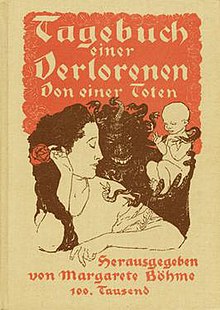Tagebuch einer Verlorenen (book)
| Tagebuch einer Verlorenen | |
|---|---|

1907 edition
|
Tagebuch einer Verlorenen (or The Diary of a Lost Girl) is a book by the German author Margarete Böhme (1867-1939). It purportedly tells the true story of Thymian, a young woman forced by circumstance into a life of prostitution. When first published in 1905, the book was said to be a genuine diary, though speculation quickly arose as to its authorship.
Due in part to its sensational subject matter, the book proved extremely popular. By the end of the 1920s, it had sold more than 1,200,000 copies, ranking it among the bestselling books of its time. One contemporary scholar has called it "Perhaps the most notorious and certainly the commercially most successful autobiographical narrative of the early twentieth century".
Böhme’s book was first published in 1905 as Tagebuch einer Verlorenen, Von einer Toten (The Diary of a Lost Girl, by One Who is Dead), by F. Fontane & Co., a leading German publisher. More than 30,000 copies were sold within the first four months of publication. Less than two years later, in 1907, a deluxe edition was issued marking more than 100,000 copies in print.
Within a few years, Tagebuch einer Verlorenen was translated into 14 languages. Interest was so great there were even pirated versions in both Poland and The Netherlands. The book remained in print more than 25 years, until it was driven out-of-print by groups seeking to suppress it at the beginning of the Nazi era.
Today, Tagebuch einer Verlorenen is accepted as a work of fiction. However, when it first published, the book was believed to be the actual diary of a young woman. Böhme claimed only to be the editor of the manuscript. Controversy arose over the story revealed in the book. In Tagebuch einer Verlorenen, Thymian turns to a life of prostitution after being seduced by her father's assistant and suffering the scorn of her family and neighbors.
The book’s publication and newsworthy sales led to speculation as to its actual author. Readers, critics, and the press were divided. Böhme and her publisher always maintained their account of the origins of the book. Some early editions even depict manuscript pages said to be in Thymian’s hand. Belief in its authenticity continued in some quarters for decades.
In 1907, Böhme published Dida Ibsens Geschichte (The History of Dida Ibsen), a popular sequel to Tagebuch einer Verlorenen. As Böhme states in the book’s forward, Dida Ibsens Geschichte was written in response to the flood of letters she received regarding the earlier book. Some readers had even written to Böhme asking where Thymian was buried.
A five-act stage play based on Tagebuch einer Verlorenen was authored by Wolf von Metzlch-Schilbach. It was published in 1906. Performances of the play were banned in some German cities. In 1906, a parody of Böhme’s book was also published. Rudolf Felseck’s Tagebuch einer andern Verlorenen, Auch von einer Toten featured a similar title and a look-alike design. In the wake of the success of Tagebuch einer Verlorenen, a number of similarly themed, lower class, women’s autobiographies were also published. At least a few of these latter books cited Böhme’s work.
...
Wikipedia
